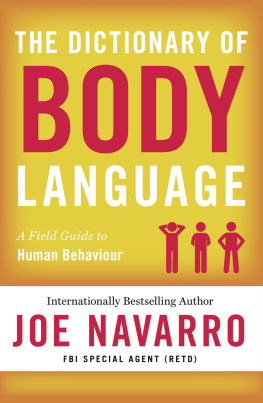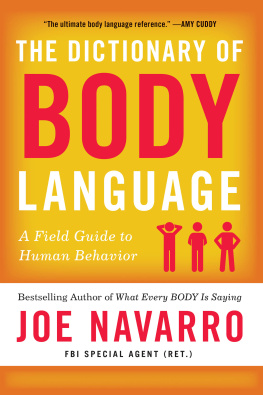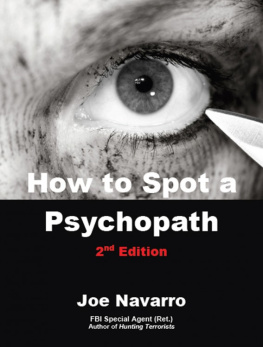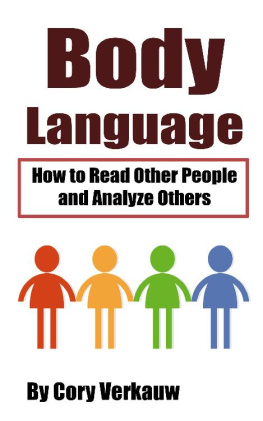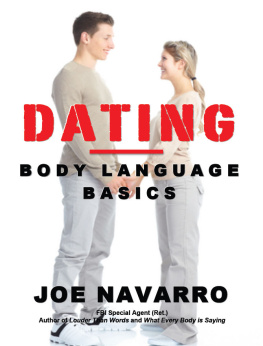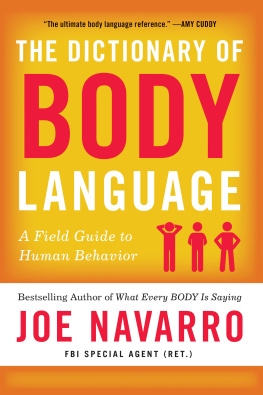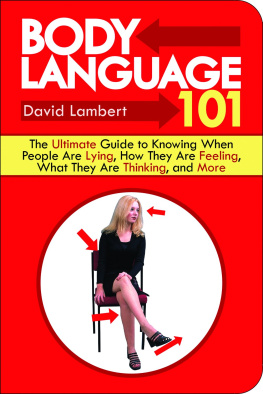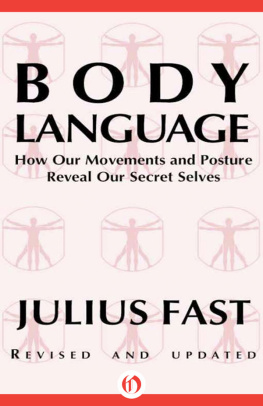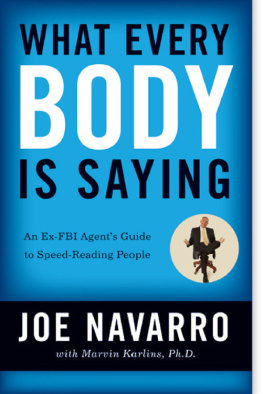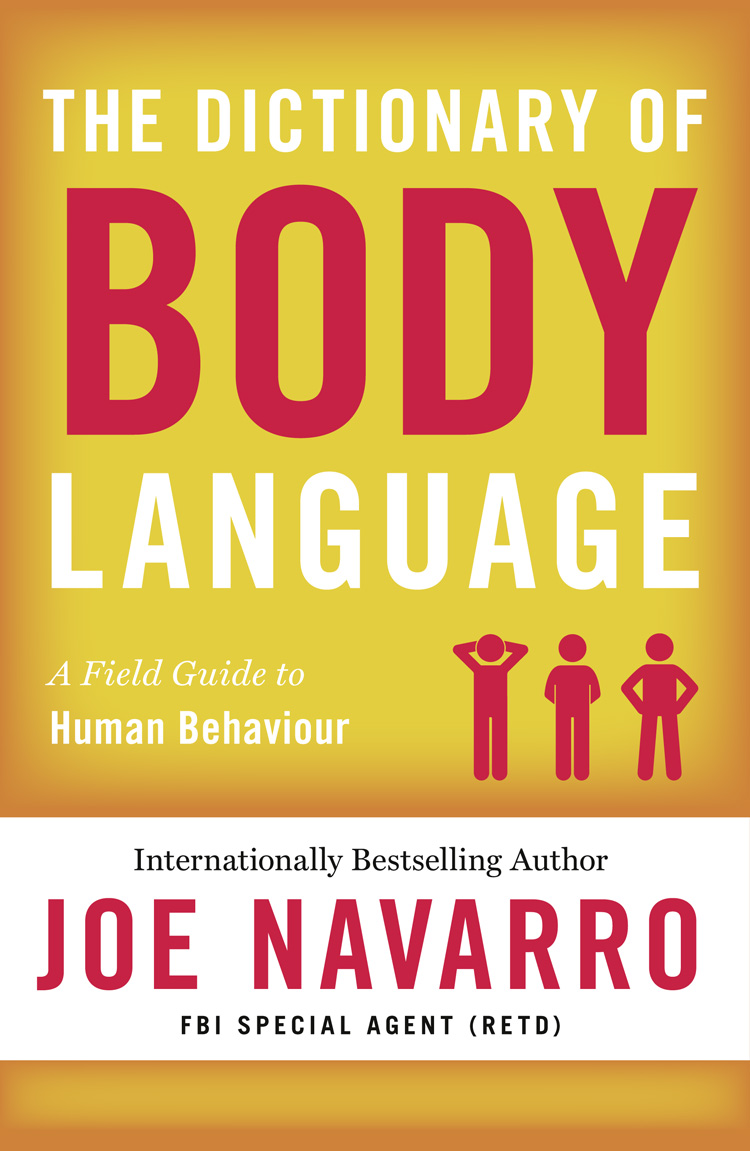If language was given to men to conceal their thoughts, then gestures purpose was to disclose them.
In 1971, at the age of seventeen, for reasons unknown to me then or now, I began to keep a journal on human behavior. I catalogued all sorts of nonverbalswhat is more generally called body language. At first it was the quirky things people did: why did they roll their eyes when they were disbelieving or reach for their neck when they heard bad news? Later it became more nuanced: why did women play with their hair while on the phone or arch their eyebrows when they greeted one another? These were small actions, but they captured my curiosity. Why did humans do such things, in such variety? What was the purpose of these behaviors?
I admit it was an odd pursuit for a teenager. My friends told me as much; they were focused on trading baseball cards, knowing who had the best batting average or kicked the most extra points that season. I was far more interested in learning the intricacies of human behavior.
In the beginning I catalogued my observations on three-by-five-inch cards for my own benefit. At that time I was unfamiliar with the work of Charles Darwin, Bronisaw Malinowski, Edward T. Hall, Desmond Morris, or my future friend Dr. David Givensthe giants in the field of human behavior. I was simply interested in how others acted, and why, and I wanted to preserve my observations. I never thought I would still be collecting them on index cards forty years later.
Over the years, I collected several thousand entries. Little did I know back then that I would later become an FBI Special Agent and would, for the next twenty-five years, use those observations as I pursued criminals, spies, and terrorists. But perhaps, given my interest in how and why people behave, that was the natural trajectory all along.
I CAME TO the United States as a refugee fleeing Communist-controlled Cuba. I was eight years old and didnt speak English. I had to adjust quicklyin other words, I had to observe and decode my new surroundings. What native speakers took for granted, I could not. My new existence consisted of deciphering the only thing that made sensebody language. Through their countenance, their look, the softness in their eyes, or the tension in their face, I learned to interpret what others implied. I could figure out who liked me, who was indifferent toward my existence, whether someone was angry or upset with me. In a strange land, I survived by observing. There was no other way.
Of course, American body language was a little different from Cuban body language. People in America spoke with a different cadence and vibrancy. Cubans got close to one another when they spoke, and often touched. In America they stood farther apart, and social touching might receive an uncomfortable glance or worse.
My parents worked three jobs each, so they did not have the time to teach me these thingsI had to learn them on my own. I was learning about culture and the influence it has on nonverbals, even if I couldnt have put it in those words at the time. But I did know that some behaviors were different here, and I had to understand them. I developed my own form of scientific inquiry, observing dispassionately and validating everything I saw not once or twice but many times before it made its way onto an index card. As my cards grew in number, certain patterns in behavior began to stand out. For one, most behaviors could be broadly categorized as markers of either psychological comfort or discomfort; our bodies reveal very accurately, in real time, our state of unease.
I would later learn that many of these comfort markers or behaviors, to be more precise, originated in the mammalian or emotional areas of the brainwhat is often referred to as the limbic system. This type of involuntary response squared with what I had seen in Cuba and was seeing now in America. At school or through the window at the corner store, people would flash their eyes with their eyebrows to greet those they truly liked. Such universal behaviors I grew to trust as authentic and reliable. What I did doubt was the spoken word. How often, after I had learned English, I heard people say they liked something when just an instant earlier I had seen their face reveal the complete opposite.
And so, too, I learned at an early age about deception. People often lie, but their nonverbals usually reveal how they actually feel. Children, of course, are terrible liars; they might nod to acknowledge they have done something bad even as they are verbally denying it. As we get older, we get better at lying, but a trained observer can still spot the signs that say something is wrong, there are issues here, a person does not appear to be completely forthcoming, or someone lacks confidence in what he is saying. Many of those signals or behaviors are collected here in this book.
As I grew older, I came to rely more and more on nonverbals. I relied on them at school, in sports, in everything I dideven playing with my friends. By the time I had graduated from Brigham Young University, I had collected more than a decades worth of observations. There, for the first time, I was living among many more cultures (east Europeans, Africans, Pacific Islanders, Native Americans, Chinese, Vietnamese, and Japanese, among others) than I had seen in Miami, and this allowed me to make further observations.
At school I also began to discover the fascinating scientific underpinnings of many of these behaviors. To take just one example: in 1974 I got to see congenitally blind children playing together. It took my breath away. These children had never seen other children yet were exhibiting behaviors that I had thought were visually learned. They were demonstrating happy feet and the steeple with their hands, despite having never witnessed them. This meant these behaviors were hardwired into our DNA, part of our paleo-circuitsthese very ancient circuits that ensure our survival and ability to communicate and are thus universal. Throughout my college career, I learned about the evolutionary basis of many of these behaviors, and throughout this book, I will reveal these often surprising facts we take for granted.
W HEN I FINISHED my studies at Brigham Young University, I received a phone call asking me to apply to the FBI. I thought it was a joke, but the next day two men in suits knocked on my door and handed me an application and my life changed forever. In those days, it was not unusual for FBI scouts to look for talent on campus. Why my name was handed up, or by who, I never learned. I can tell you that I was more than elated to be asked to join the most prestigious law enforcement agency in the world.
I was the second-youngest agent ever hired by the FBI. At the age of twenty-three I had again entered a new world. Though I felt unprepared in many ways to be an agent, there was one domain I had mastered: nonverbal communication. This was the only area where I felt confident. FBI work is, for the most part, about making observations. Yes, there are crime scenes to process and criminals to apprehend, but the majority of the job is talking to people, surveilling criminals, conducting interviews. And for that I was ready.
My career in the FBI spanned twenty-five years, the last thirteen of which I spent in the Bureaus elite National Security Behavioral Analysis Program (NS-BAP). It was in this unit, designed to analyze the top national security cases, that I got to utilize my nonverbal skills as if on steroids. This unit, comprising just six agents selected from among twelve thousand FBI Special Agents, had to achieve the impossible: identify spies, moles, and hostile intelligence officers seeking to do harm to the United States under diplomatic cover.

